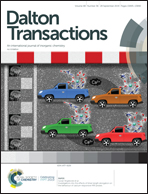A new diphosphate Ba2LiGa(P2O7)2: synthesis, crystal structure and Eu3+-activated fluorescence performance†
Abstract
Finding new luminescent materials is always a meaningful goal in the field of photoelectricity studies. Herein, a new diphosphate compound Ba2LiGa(P2O7)2 (BLGP) was prepared using a high-temperature flux method. It displays an anionic chain structure of [LiGa(P2O7)2]∞, constructed from P2O7, LiO5 and GaO6 polyhedra. The Ba2+ ions are distributed in the voids between the [LiGa(P2O7)2]∞ chains, bonding them and maintaining charge balance. To test its potential as a luminescent host, Eu3+ doped phosphors BLGP:xEu3+ (x = 0.05, 0.10, 0.15, 0.20, 0.25 and 0.30) were synthesized and studied in detail. Upon 394 nm light irradiation, BLGP:xEu3+ showed bright orange emission with a dominant peak at 595 nm due to the 5D0 → 7F1 transition of Eu3+. The optimal doping amount of Eu3+ is 0.20, and the internal quantum efficiency of the phosphor B1.8LGP:0.2Eu3+ was determined to be 67%. The temperature quenching behavior of B1.8LGP:0.2Eu3+ was studied, suggesting that the photoluminescence (PL) intensity decreased to about 50% at 450 K due to thermal quenching. All these features show that this compound is a good luminescent host material for Eu3+ activators.



 Please wait while we load your content...
Please wait while we load your content...